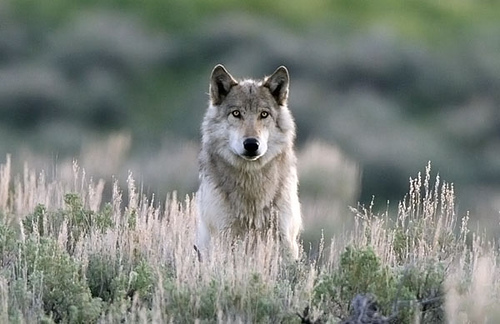What we know, what we think, and what we’re finding out 20 years after the return of the top dog to the Northern Rockies
Written by Kyle Magin
There are a few different ways to comprehend the two-decade mark of the return of wolves to Yellowstone National Park.
There’s the bleeding heart’s joy over hearing the wolf’s song again in the park’s Lamar Valley—the American Serengeti. It was extinguished from this forest-and-mountain-ringed-meadow in the 1920s, not to be heard again until the winter of 1995.
There’s the bean counter’s cold-blooded calculations. From the original 1995 and 1996 introductions of 31 Canadian wolves, and the 1997 introduction of 10 more from Northwestern Montana, there are today close to 500 wolves in the world’s first national park.
In Yellowstone’s multi-billion dollar tourism economy, more than 44 percent of visitors said they came to try to see or hear wolves according to a 2005 tourism report.
There’s the hunter’s and the rancher’s bitching. Wolves took 256 sheep and 41 cattle in areas surrounding the park in the first 10 years after reintroduction. While it was less than expected and a fraction of the 355,000 sheep and 1.3 million cattle in Wyoming, that’s easier to say when you don’t make your living off of those sheep and cattle.
Hunters saw vast declines in their personal “elk farm”—that’s how wildlife biologist and Yellowstone’s wolf reintroduction head man Doug Smith termed the park pre-reintroduction, before their historic predator showed back up near Roosevelt’s famous arch. But Wyoming, Montana and Idaho have all reaped millions in revenues when the wolf was de-listed late in the 2000s and made available for hunting.
You can view the last 20 years through an ecologist’s filter, as I prefer to. Studies over the past 10 years are finding Mufasa-explaining-the-circle-of-life-to-Simba benefits of the return of an apex predator.
An overpopulation of sickly elk with almost no natural predators ate everything in sight. Trees disappeared from around streams, and along with them songbirds and beavers. Beavers stopped making dams and ponds, which create wetlands and retain water so it releases downstream (to ranches outside the park, ironically) in a controlled fashion over the course of the year rather than all at once following a storm.
Then the wolves came back. By now some of their pack names are legendary: the Druids, the Beartooths, the Nez Perce.
Elk, wary of being eaten, left the stream-zones. They got healthier and leaner now that they had to stay on their toes. The cottonwoods and willows came back. Warblers came to live in the trees. Beavers came to knock a few down. They created mud flats for more trees to grow in, and wetlands to retain rain water. All sorts of plants, fish, amphibians and reptiles found homes in the reeds and willows again.
The top dog came home, and nature balanced itself back out.
Viewed through any lens, loving, hateful or clinical—the reintroduction of wolves to Yellowstone is one of the most momentous milestones in our lifetime. A landscape-changing predator was returned to a people who had originally chased it off. A symbol of America’s wilds—competitor, benevolent force of nature, historic piece of the puzzle—was back in the fold.
Pulling it off wasn’t easy and is still a struggle. But I think it made us better.
Long live Yellowstone’s wolves—because you need a thorn in your side, a master on the food chain and a living, breathing reminder that something calls all those beautiful waterfalls, mountains and geysers home.
